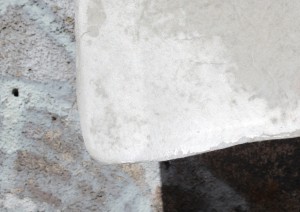 Formula/ chemical composition: Polyvinyl acetat: C4H6O2 Chopped Strand Mat Laminate 30% E-glass: SiO2 Material description: Multiple layers of fibreglass mat and diluted polyvinyl acetate adhesive are combined on a mould and allowed to cure. The resultant material is flexible, translucent, whitish-yellow in colour, and fairly strong. If properly cast the moulded surface is very smooth. Extraction process: Ethylene and acetic acid are combined in the presence of oxygen, and then polymerized. Silica fibres are extruded into multiple thin glass fibres suitable for textiles and woven. Basic properties: Density: 98.5 kg/m3 Carbon footprint (average): 5.4 (glass-fiber); 17.2 (adhesive) Recyclable: yes Laser: yes Small Laser: yes Milling: yes 3D-Printing: no Advantage in context of digital fabrication: Complete freedom of form making and range of options in the creative process. Thickness/opacity of material can be customized. Material Suppliers: Servei Estació –
Formula/ chemical composition: Polyvinyl acetat: C4H6O2 Chopped Strand Mat Laminate 30% E-glass: SiO2 Material description: Multiple layers of fibreglass mat and diluted polyvinyl acetate adhesive are combined on a mould and allowed to cure. The resultant material is flexible, translucent, whitish-yellow in colour, and fairly strong. If properly cast the moulded surface is very smooth. Extraction process: Ethylene and acetic acid are combined in the presence of oxygen, and then polymerized. Silica fibres are extruded into multiple thin glass fibres suitable for textiles and woven. Basic properties: Density: 98.5 kg/m3 Carbon footprint (average): 5.4 (glass-fiber); 17.2 (adhesive) Recyclable: yes Laser: yes Small Laser: yes Milling: yes 3D-Printing: no Advantage in context of digital fabrication: Complete freedom of form making and range of options in the creative process. Thickness/opacity of material can be customized. Material Suppliers: Servei Estació –
http://www.serveiestacio.com/
Form X –
http://www.formx.es/
Price: glass-fiber: 2,15 € / 1 m2; adhesive: 8 € / kg References:  Aperture Fiberglass Installation // Cameron Northrop Illustrates well the technique of moulding and fabricating. This project demonstrates efficiency with materials through the use of modules when casting fibreglass. Also the idea of embedding different materials inside the layers of fiberglass is interesting.
Aperture Fiberglass Installation // Cameron Northrop Illustrates well the technique of moulding and fabricating. This project demonstrates efficiency with materials through the use of modules when casting fibreglass. Also the idea of embedding different materials inside the layers of fiberglass is interesting.
http://cargocollective.com/cameron_northrop/AFS
 New Amsterdam Pavilion // UNstudio This sculptural project shows how a complex monolithic shape can be built from fibreglass. The range of freedom fibreglass offers in form and scale is apparent here. It is particularly interesting because despite looking very futuristic it was built by hand.
New Amsterdam Pavilion // UNstudio This sculptural project shows how a complex monolithic shape can be built from fibreglass. The range of freedom fibreglass offers in form and scale is apparent here. It is particularly interesting because despite looking very futuristic it was built by hand.
http://vanguarq.wordpress.com/2009/10/01/new-amsterdam-pavilion-unstudio/